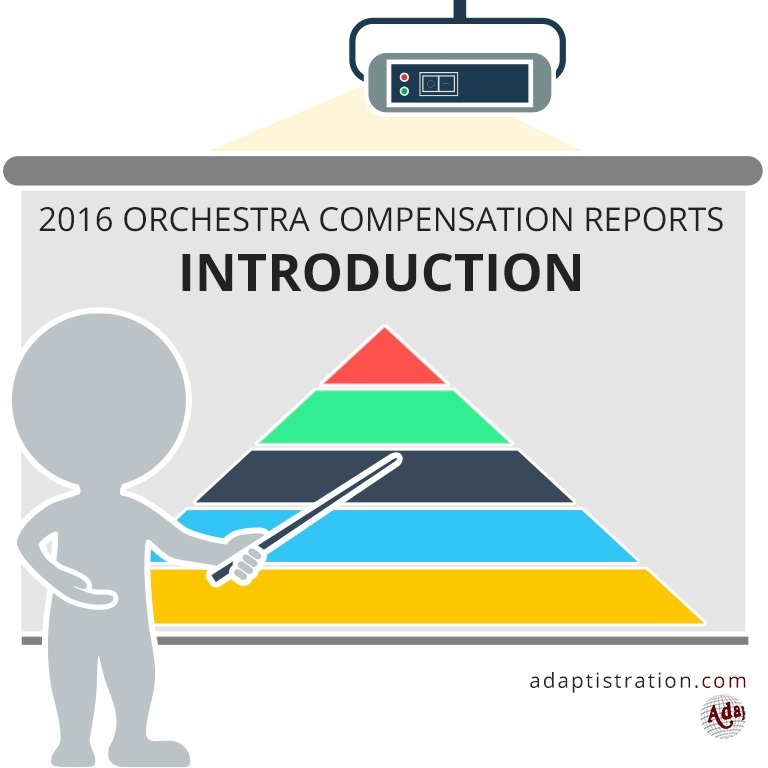The 2009/10 season was the first to suffer the brunt of the economic downturn but its impact on executive compensation varied wildly from one group to the next. This season experienced some of the largest gaps between compensation extremes with some executives enjoying modest to healthy increases while others experienced sizable cuts. But in the end, and for the first time since the 2000/01 season, the average orchestra executive earned less in 2009/10 than the previous season.
WHAT’S NEW FOR THE 2012 REPORTS
 Although the reports cover the 2009/10 season, the orchestras which have liquidated and ceased operations since that time have been removed from the list (Honolulu, New Mexico, and Syracuse). If you’re curious about data from those organizations from the 2009/10 season through when they went bankrupt, you can still find their respective 990’s at guidestar.org.
Although the reports cover the 2009/10 season, the orchestras which have liquidated and ceased operations since that time have been removed from the list (Honolulu, New Mexico, and Syracuse). If you’re curious about data from those organizations from the 2009/10 season through when they went bankrupt, you can still find their respective 990’s at guidestar.org.
Likewise, some groups were removed due to an increase in the minimum total expenditure threshold to be included in the reports. At the same time, those were replaced by new entries including Fresno Phil, Monterey Symphony, National Symphony, Orchestra Iowa, Portland (ME) Symphony, and Sarasota Orchestra. Of those, National has traditionally been filtered out due to difficulty with extracting some of the figures from the overall Kennedy Center data and Sarasota flew under the radar for a few years due to their branding change (they used to be Florida West Coast Symphony).
“Where did the musician compensation figures go?”
In short, this year’s reports will not include that information. Detailed explanations are available in the series’ introduction article and in order to help make up for that missing data, this year’s reports will include compensation figures as well as the figures reported from the previous season. This should make it a bit easier for everyone to see dollar for dollar changes between seasons.
WHERE THE DATA COMES FROM
In order to provide information that is as accurate as possible, data from the 2009/10 season is gathered from the following sources:
- Executive compensation figures were obtained from their respective orchestra’s IRS Form 990 for the 2009/10 concert season.
- Total Expenditures were also obtained from each respective orchestra’s IRS Form 990 for the 2009/10 concert season (Due to their relationship within a larger performing arts structure, Total Expenditure figures for National Symphony and Atlanta Symphony are unavailable and the figures here are representative approximations.).
Adaptistration makes no claim to the accuracy of information from documents compiled or reported by external sources. If you have reason to believe any of the information is inaccurate or has changed since reported in any of the above sources and you can provide documentation to such effect, please feel free to submit a notice.
WHAT THE NUMBERS DON’T SHOW
It is important to remember that the numbers shown do not always convey a complete compensation picture. For example, an orchestra executive may have had a large increase in salary due to a contractually mandatory severance or deferred compensation package. Additionally, if any executive was not employed for a full season, the documents used to gather this data do not indicate how much of the season the individual received a salary. As such, the cumulative compensation may artificially inflate annual earnings. Conversely, reported figures may not reflect bonuses or other incentive payments and may therefore under report what executives actually earn; as a result, the cumulative compensation for executive directors may or may not be more than what is listed.
If you’re curious about exactly how much of a difference can exist, the recent Philadelphia Orchestra bankruptcy proceeding shed a sliver of light onto the river of unspecified compensation executives can garner by way of perks and benefits. Details were reported in an article published on 3/2/2012.
QUICK FACTS
From the 2008/09 to the 2009/10 season…
- …the average executive compensation decreased 6.05 percent.
- …the Los Angeles Philharmonic had the highest compensated orchestra executive at $1,397,746.
- …the average orchestra total expenditure increased 7.75 percent.
TOP 10 EARNERS
- Los Angeles Philharmonic: $1,397,746
- New York Philharmonic: $860,210
- Boston Symphony: $603,171
- Atlanta Symphony: $593,294
- San Francisco Symphony: $495,044
- Chicago Symphony: $482,560
- Cleveland Orchestra: $460,958
- Dallas Symphony: $436,670
- Saint Louis Symphony: $406,327
- Minnesota Orchestra: $404,049




Hoo boy. Some questions and comments –
Why is the LAPO overall budget so much higher than everyone else’s? Does that $96 million include non-LAPO performances, or…? How does Deborah Borda rate? And Zarin Mehta, for that matter.
The executive compensation at Atlanta looks out of proportion to its budget.
Good observations Lisa, one area where some organizations differ is whether or not they own and operate their own venue. In those cases, overall expenses will be higher compared to groups who don’t and all things being equal, the CEO responsibilities would be higher and therefore be more likely to justify higher compensation than a peer at an ensemble with similar artistic expenses but minus the venue expenses.
As for comparing one exec against another, that is ultimately up to each organization’s board, but that’s a long and worthwhile conversation all on its own. We’ve touched on it from time to time over the years and in a nutshell, one of the best ways to think about it is whether or not a board gets confused with rewarding effort vs. achievement.
Lastly, it’s worth pointing out that one of the reasons I don’t use the term “budget” in the reports is due to instances every now and then of unusual spikes in expenses, such as capital construction projects. You won’t see the new expenditure plateau until the following season but the annual outflow of cash will be much higher in those sorts of instances.
It would be interesting to see salary as % of total expenditure to get some, perhaps not an entirely accurate, sense of relative high earners.
That’s been played with some in the review’s early years but the higher an orchestra’s budget, the less relevant it becomes. Add to that the basic inclination to create an evenly applicable comparison and it never really fit. However, if time and/or funding ever materialized to do a continued series that drilled down into those stats for different budget categories, that could produce some very interesting results.
I just made Marc’s exactly remark on the MD posting! And thanks, Drew, for the detailed response.
You’re welcome! Although it’s fair to point out that the venue own/operate issue has far less impact on MD compensation. Consequently, overall artistic expenditures and related activity is a more appropriate benchmark.
The table of figures reflects that CEO pay is higher in Atlanta than in Chicago and Cleveland and Minnesota. Baltimore used to be equivalent, if not slightly higher, to Atlanta. Musician (not soloists, conductors) pay is the largest expense in any American orchestra, but, the business model of these non-profits are being guided by Robert J. Flanagan’s presentation of musician pay as “cost disease”. Musicians are are a commodity that is devalued by their very numbers….”it’s nothing personal”, we are told.